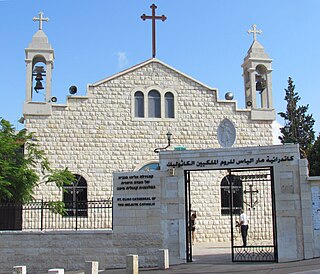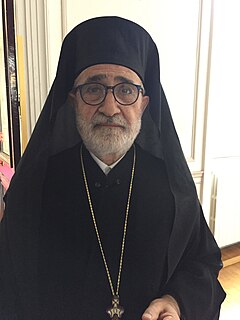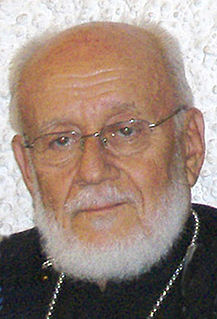Related Research Articles

The Melkite Catholic Patriarchate of Antioch is the only actual residential Patriarchate of the Melkite Greek Catholic Church. It was formed in 1724 when a portion of the Orthodox Church of Antioch went into communion with Rome, becoming an Eastern Catholic Church, while the rest of the ancient Patriarchate continues in full communion with the rest of the Eastern Orthodox Church.

The Catholic Church in Syria is part of the worldwide Catholic Church, under the spiritual leadership of the Pope in Rome.

Demetrius I Qadi was Patriarch of Antioch and All the East, and Alexandria and Jerusalem of the Melkite Greek Catholic Church from 1919 until 1925.

Melkite Greek Catholic Archeparchy of Akka is an Eastern Catholic diocese of Melkite Greek Catholic Church, directly subject to the Melkite Patriarch of Antioch. Its Cathedral episcopal see is St. Elijah Greek-Melkite Cathedral, in Haifa.
Habib Bacha, SMSP was Melkite Archbishop of the Melkite Greek Catholic Archeparchy of Beirut and Byblos.
Melkite Greek Catholic Archeparchy of Baalbek is a diocese of the Catholic Church immediately subject to the Patriarchate of Antioch of the Melkites. It is currently governed by Archbishop Elias Rahal.
Melkite Greek Catholic Archeparchy of Petra and Philadelphia in Amman is a branch of the Melkite Greek Catholic Church immediately subject to the Patriarchate of Antioch of the Melkites. In 2007 there were 27,000 baptized. Joseph Gébara was elected Archeparch on February 20, 2018.
Mikhayl Assaf was the second archbishop of the Melkite Greek Catholic Church of the Melkite Greek Catholic Archeparchy of Petra and Philadelphia in Amman. He was the successor to Archbishop Paul Salman.

Nicolas Antiba is the current archbishop of the Melkite Greek Catholic Archeparchy of Bosra and Hauran.

Boulos Nassif Borkhoche (born Paul Victor Borkhoche, SMSP was a retired Archbishop of the Melkite Greek Catholic Archeparchy of Bosra and Hauran in Syria.
Nicolas Naaman, SMSP was an archbishop of the Melkite Greek Catholic Archeparchy of Bosra and Hauran in Syria.
Pierre Chami, SMSP was an Archbishop of the Melkite Greek Catholic Archeparchy of Bosra and Hauran in Syria.
Basilio Haggiar, BS was an archbishop of the Melkite Greek Catholic Archeparchy of Bosra and Hauran in Syria and Melkite Greek Catholic Archeparchy of Sidon in Lebanon.

Melkite Greek Catholic Archeparchy of Aleppo is an archeparchy of the Melkite Greek Catholic Church located in Syria, based in Aleppo. Its current archeparch is Jean-Clément Jeanbart.
Melkite Greek Catholic Archeparchy of Latakia is an eparchy of the Melkite Greek Catholic Church immediately subject to the Holy See. In 2009 there were 14,500 baptized. It is currently governed by archeparch Nikolaki Sawaf.
Melkite Greek Catholic Archeparchy of Sidon is a diocese of the Melkite Greek Catholic Church suffragan of the Melkite Greek Catholic Archeparchy of Tyre. In 2010 there were 32,000 baptized. It is currently governed by Archeparch Elie Bechara Haddad, BS.
Melkite Greek Catholic Archeparchy of Homs is a nominally Metropolitan Archeparchy of the Melkite Greek Catholic Church in central Syria. It was established on March 4, 1849 and has no suffragan, but two merged-in eparchial titles.
The Maronite Catholic Eparchy of Latakia or Latakia of the Maronites is an eparchy of the Maronite Catholic Church. In 2011 there were 35,000 members. It is governed by Eparch Antoine Chbeir.

Maronite Catholic Archeparchy of Beirut is an archeparchial seat of the Maronite Church immediately subject to the Holy See in Lebanon. As of 2012, there were 232,000 baptized. It is currently ruled by Archeparch Paul Abdel Sater.
References
- ↑ [Eletto dal sinodo della Chiesa melchita il 22 giugno 2012 (cfr. dal sito ufficiale del Patriarcato), ha ottenuto l'assenso di papa Francesco il 2 maggio 2013]
- ↑ pgc-lb.org
